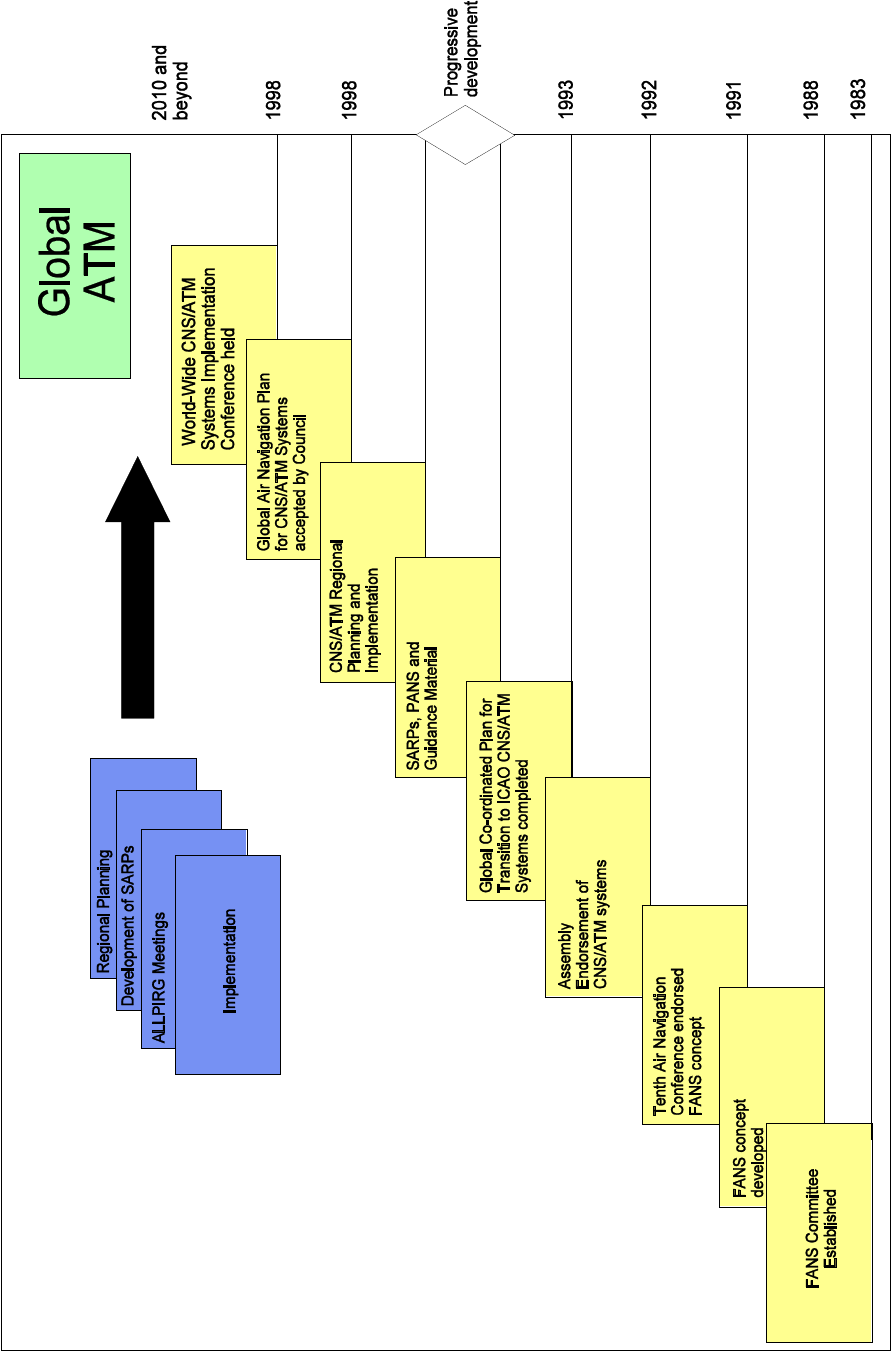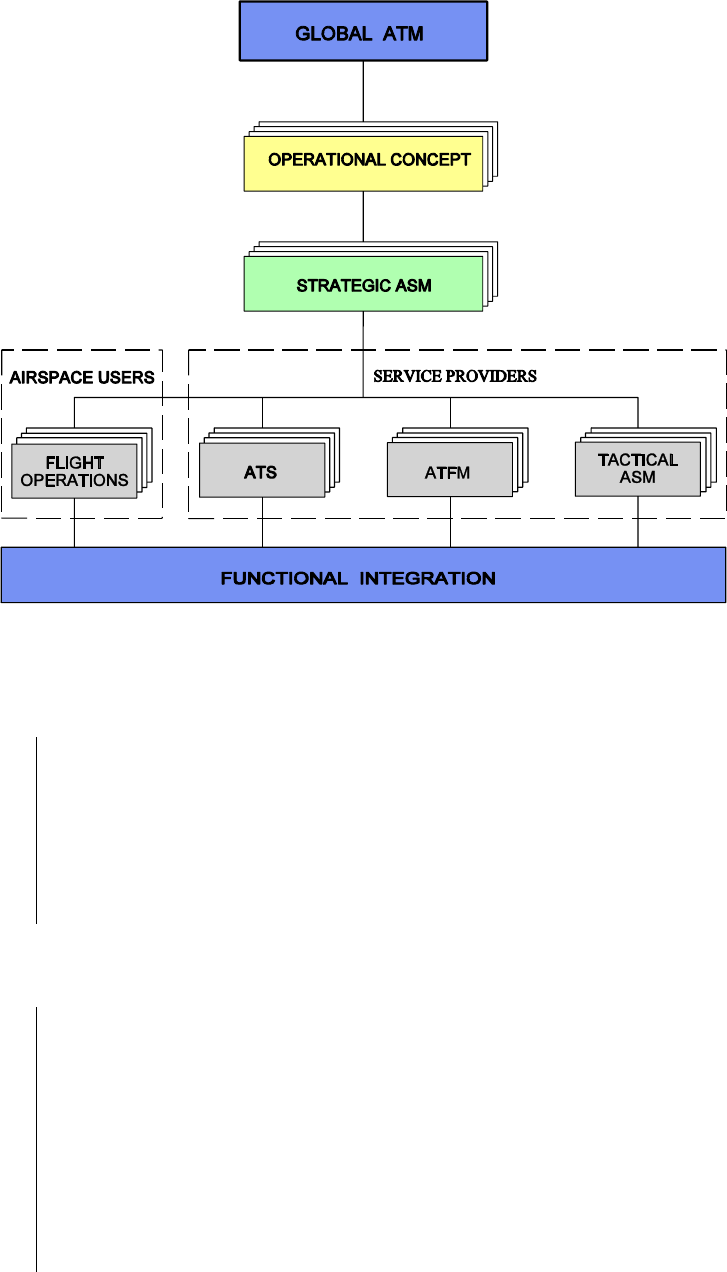
Communications, navigation, and surveillance systems, employing digital
technologies, including satellite systems together with various levels of
automation, applied in support of a seamless global air traffic management
system.
To foster implementation of a seamless, global air traffic management
system that will enable aircraft operators to meet their planned times of
departure and arrival and adhere to their preferred flight profiles with
minimum constraints and without compromising agreed levels of safety.
To develop a seamless, globally co-ordinated system of air navigation
services that will cope with world-wide growth in air traffic demand while:
C improving upon the present levels of safety;
C improving upon the present levels of regularity;
C improving upon the over-all efficiency of airspace and airport
operations, leading to increased capacity;
C increasing the availability of user-preferred flight schedules and
profiles; and
C minimizing differing equipment carriage requirements between
regions.
CNS/ATM SYSTEMS
DEFINITION
STRATEGIC VISION
MISSION OF IMPLEMENTATION

1
This high level executive summary was developed with the intention of
presenting the reader with a synopsis of the contents, objectives and
strategy of the Global Plan. This high level view provides a summary of
the substantial material contained in each of the individual chapters of the
Global Plan. The summary also generally describes ICAO’s approach
toward planning for implementation of communications, navigation and
surveillance/air traffic management (CNS/ATM) systems at the global,
regional and national levels, aiming at the merging of all planning into a
coherent, unified strategy. Chapters of the Global Plan are indicated to the
reader for easy reference to more in depth information.

2

3
INTRODUCTION (Chapters 1, 2 and 3)
H
ISTORICAL SYNOPSIS
The FANS concept,
which came to be
known as the
CNS/ATM systems,
involves a complex and
interrelated set of
technologies,
dependent largely on
satellites.
In 1983, the Council of ICAO determined that the systems and procedures supporting civil
aviation had reached their limits, and established the Special Committee on Future Air
Navigation Systems (FANS Committee). In concluding their work in 1989, the FANS
Committee determined that it would be necessary to develop new systems that would overcome
limitations of conventional systems and allow air traffic management (ATM) to develop on a
global scale. In July 1989, the ICAO Council established the Special Committee for the
Monitoring and Co-ordination of Development and Transition Planning for the Future Air
Navigation System (FANS Phase II Committee). In October 1993, the FANS Phase II
Committee completed its work. The FANS Phase II Committee recognized that implementation
of related technologies and expected benefits would evolve over a period of time.
In September 1991, the Tenth Air Navigation Conference endorsed the concept for a future air
navigation system as developed by the FANS Committees. The FANS concept, which came to
be known as the CNS/ATM systems, involves a complex and interrelated set of technologies,
dependent largely on satellites.
B
ENEFITS
CNS/ATM systems will
improve the handling
and transfer of
information, extend
surveillance and
improve navigational
accuracy.
CNS/ATM systems will improve the handling and transfer of information, extend surveillance
and improve navigational accuracy. This will lead to, among other things, reductions in
separation between aircraft, allowing for increased airspace capacity. Advanced CNS/ATM
ground-based systems will exchange data directly with flight management systems aboard
aircraft through data link. This will benefit the ATM provider and airspace user by enabling
improved conflict detection and resolution through intelligent processing, providing for the
automatic generation and transmission of conflict free clearances, as well as offering the means
to adapt quickly to changing traffic requirements. As a result, the ATM system will be better
able to accommodate an aircraft’s preferred flight profile and help aircraft operators to achieve
reduced flight operating costs and delays.
G
LOBAL PLANNING
The first plan of action
was the ICAO Global
Co-ordinated Plan for
Transition to ICAO
CNS/ATM Systems.
In order to progress toward implementation of CNS/ATM systems, a plan of action was needed.
The first such effort towards developing a plan was the ICAO Global Co-ordinated Plan for
Transition to ICAO CNS/ATM Systems. In 1996, the ICAO Council recognized that this plan
had served its purpose well and had made a significant contribution toward realizing the vision
established by the FANS Committee. However, the Council concluded that the CNS/ATM
systems had matured and, therefore, a more concrete plan which would include all
developments, while putting focus on regional implementation, was required.
In 1996 the Council
directed the ICAO
Secretariat to revise the
Global Plan as a “living
document”.
In 1996 the Council directed the ICAO Secretariat to revise the Global Plan as a "living
document" comprising technical, operational, economic, financial, legal and institutional
elements, offering practical guidance and advice to regional planning groups and States on
implementation and funding strategies, which should include technical co-operation aspects.
These aspects of CNS/ATM systems are addressed in the Global Air Navigation Plan for
CNS/ATM Systems.

4
A high-level view of expected benefits of the new systems

5
PLANNING STRUCTURE
The Global Plan has
been developed so that
it has a clear and
functional relationship
with the regional air
navigation plans.
The tables in Volume II
will form the framework
to guide the
implementation of
CNS/ATM systems on
a global basis.
The Global Plan has been developed so that it has a clear and functional relationship with the
regional air navigation plans. This has been accomplished by dividing the Global Plan into two
parts. Volume I will guide further development of the operational requirements and planning
criteria of the regional air navigation plans. The tables in Volume II will form the framework
to guide the implementation of CNS/ATM systems on a global basis, using the traditional
regional planning processes, leading to a global, integrated ATM system. The document will
therefore offer, under one cover, a global snapshot of progress achieved and work remaining
toward implementation of CNS/ATM systems, thereby serving as a consolidated planning tool.
ATM
OPERATIONAL CONCEPT
The Global Plan
broadly describes an
ATM operational
concept.
The Global Plan broadly describes an ATM operational concept being developed by ICAO,
reflecting latest available information on ATM conceptual work. This description and emerging
concept will offer a high-level vision in order to assist in the determination of ATM
requirements that would guide the development of future CNS/ATM system elements and their
functionalities, thereby allowing optimum benefits to be attained.
ELEMENTS OF THE GLOBAL PLAN
C
OMMUNICATIONS (Chapter 5)
Communications will
increasingly take place
via digital data link.
The regular use of data
transmission for ATM
purposes will offer
many new possibilities
and opportunities.
With CNS/ATM systems, communications will increasingly take place via digital data link over
existing communications channels. Satellite data and voice communications, capable of global
coverage are also being introduced. Secondary surveillance radar Mode S, which is increasingly
being used for surveillance in high-density airspace, also has the capability of transmitting
digital data between air and ground. An aeronautical telecommunications network will provide
for the interchange of digital data between end users over dissimilar air-ground and ground-
ground communication sub-networks. The regular use of data transmission for ATM purposes
will introduce many changes in the way that communication between air and ground takes place,
and will at the same time offer many new possibilities and opportunities.

6
A structured approach to the work on global ATM
N
AVIGATION (Chapter 6)
Improvements in
navigation include the
progressive
introduction of area
navigation (RNAV)
capabilities along with
the global navigation
satellite system
(GNSS).
Improvements in navigation include the progressive introduction of area navigation (RNAV)
capabilities along with the global navigation satellite system (GNSS). These systems provide
for world-wide navigational coverage and are being used for world-wide en-route navigation and
for non-precision approaches. With appropriate augmentation systems and related procedures,
it is expected that these systems will also support most precision approaches.
S
URVEILLANCE (Chapter 7)
Aircraft will
automatically transmit
their position and other
data such as heading,
speed and other useful
information contained
in the flight
management system,
via satellite or other
communication links, to
an air traffic control
(ATC) unit.
Traditional secondary surveillance radar modes will continue to be used for surveillance, along
with the gradual introduction of Mode S in both terminal areas and high-density continental
airspace. The major breakthrough however, is with the implementation of automatic dependent
surveillance (ADS). Using ADS, aircraft will automatically transmit their position, and other
data such as heading speed and other useful information contained in the flight management
system, via satellite or other communication links, to an air traffic control (ATC) unit. Software
is currently being developed that would allow these data to be used directly by ground
computers to detect and resolve conflicts. ADS-broadcast (ADS-B) is another concept for
dissemination of aircraft position information. Using this method, aircraft periodically broadcast
their position to other aircraft as well as to ground systems.

7
AIR TRAFFIC MANAGEMENT (Chapter 4)
The advancements in
CNS technologies will
serve to support ATM.
When considering implementation of new communications, navigation and surveillance systems
and all of the expected improvements, it can be seen that the advancements in CNS technologies
will serve to support ATM. When referring to ATM in the future concept, much more than just
air traffic control is meant. In fact, ATM will include air traffic services, air traffic flow
management, airspace management and the ATM-related aspects of flight operations. An
integrated global ATM system should fully exploit the introduction of new technologies through
international harmonization of standards and procedures. Ultimately, this would enable the
aircraft operators to conduct their flights in accordance with their preferred trajectories,
dynamically adjusted, in the most optimum and cost-efficient manner.
M
ETEOROLOGY (Chapter 8)
The global ATM system
will require access to
global meteorological
information on a far
shorter time scale than
has been customary in
the past.
The global ATM system will require access to global meteorological information on a far
shorter time scale than has been customary in the past. In many cases virtually "instant" access,
including real-time data, will be required. Such stringent requirements will dictate that as many
of the processes as possible must be automated. Development of the meteorological systems to
support a global ATM system is taking place, specifically in, among others, the automatic uplink
of aerodrome weather observations to aircraft on approach or departure, and dedicated systems
to detect hazardous weather; and, automatic downlink of meteorological information derived
from aircraft sensors (wind, temperature, turbulence and humidity) to ATC computers.
A
ERONAUTICAL INFORMATION SERVICES (Chapter 9)
With the increased
quantity of aeronautical
information and with
the clearly defined
operational requirement
for aeronautical data
quality, the emerging
aeronautical databases
are improving, among
other things, the speed,
efficiency and cost-
effectiveness of
aeronautical
information.
For CNS systems to provide maximum benefits through enhanced ATM, the support of
aeronautical information services is essential. The role and importance of aeronautical
information will continue to change significantly with the implementation of area navigation,
required navigation performance (RNP) and airborne computer-based navigation systems. An
integrated ATM system along with the requirement for precise navigation capability will
therefore require high quality aeronautical information in order to be able to provide guidance
for gate to gate operations between origin and destination.
With the increased quantity of aeronautical information and with the clearly defined operational
requirement for aeronautical data quality, the emerging aeronautical databases are improving,
among other things, the speed, efficiency and cost-effectiveness of aeronautical information. For
these reasons, many States have begun or are planning to begin developing electronic
aeronautical databases with the intent to use such data to prepare and update their aeronautical
information publications and/or to exchange electronic aeronautical information between all
parties concerned.
H
UMAN RESOURCE DEVELOPMENT AND TRAINING NEEDS (Chapter 10)
A seamless air
navigation environment
will require an
international team that
is prepared to perform
their jobs in such an
environment.
A major goal of CNS/ATM systems is to create a seamless global air navigation system. A
seamless air navigation environment will require an international team that is prepared to
perform their jobs in such an environment. To achieve this, it is essential that personnel
throughout the world who will form this team receive a consistent, quality level of training. The
evolution of aviation technologies has been gradual in the past, and trainers have, for the most
part, been able to meet the challenges associated with change even though sophisticated training
methodologies and tools have not always been at their disposal. However, the new CNS/ATM

8
systems are based on many new concepts, and their implementation presents a greater challenge
to trainers.
L
EGAL ISSUES (Chapter 11)
It has been generally
agreed that there is no
legal obstacle to the
implementation of
CNS/ATM systems and
that there is nothing
inherent in CNS/ATM
systems which is
inconsistent with the
Chicago Convention.
The legal framework for provision of air traffic management services currently in place, the
Chicago Convention and its Annexes, governs the conduct of services providers (including
providers of elements of the services, such as navigation aid positioning signals), and users
(including air operators). CNS/ATM systems will bring significant benefits to States. There is
a consensus that GNSS shall be compatible with the Chicago Convention, its Annexes and other
principles of international law.
O
RGANIZATIONAL AND INTERNATIONAL CO-OPERATIVE ASPECTS (Chapter 12)
States will need to
co-operate in order to
ensure optimal benefits
from the efficiency
CNS/ATM systems
offer.
Implementation of
CNS/ATM systems will
be facilitated where
financially-autonomous
bodies have been
established to operate
air navigation services.
Two important characteristics of major CNS/ATM components are their capacity to serve a
large number of States, even regions of the world, and the major investments usually involved
in their implementation. This has organizational implications because States will need to
co-operate in order to ensure optimal benefits from the efficiency CNS/ATM systems offer. The
structure of the international co-operative effort required will differ depending on the
implementation option chosen for a specific system’s component and the States involved. The
international co-operative effort can be in the form of an International Operating Agency, a Joint
Charges Collection Agency or an ICAO Joint Financing Arrangement.
At the national level,
implementation of CNS/ATM systems will be facilitated where
financially-autonomous bodies have been established to operate air navigation services. Such
authorities may also operate airports or be in the form of an autonomous civil aviation authority.
Whether at the national or international level, financing of CNS/ATM systems components as
well as other air navigation services infrastructure will be enhanced where such autonomous
bodies are responsible for infrastructure provision and operation.
C
OST/BENEFIT AND ECONOMIC IMPACT (Chapter 13)
The providers of air
traffic services, the
users of these services
and financing
organizations all need
to be advised of the
financial implications
and convinced of the
economic viability of
new CNS/ATM
systems.
To ensure the successful implementation of CNS/ATM systems, the providers of air traffic
services, the users of these services and financing organizations all need to be advised of the
financial implications and convinced of the economic viability of new CNS/ATM systems. This
can be achieved through a comprehensive cost/benefit analysis which includes the financial
consequences affecting all the partners involved in the implementation process. Cost/benefit
analysis can also provide guidance on the appropriate timing for implementation of various
elements of a new system. In addition, to demonstrate the financial viability, business cases for
homogeneous ATM areas could be conducted at the regional, sub-regional or national level.
The implementation of CNS/ATM systems will contribute positively towards the economic
impact of civil aviation and could also improve the environmental impact.

9
FINANCIAL ASPECTS (Chapter 14)
The costs of CNS/ATM
systems elements
could be recovered in
accordance with ICAO
policy guidance.
Financing of basic
systems elements may,
in many cases, need to
be a joint venture by
the States involved at
the regional or global
level.
The costs of CNS/ATM systems elements could be included in the cost basis for air navigation
services charges and, where relevant, airport charges, and recovered in accordance with the
principles contained in the Convention on International Civil Aviation (Doc 7300) and the
Statements by the Council to Contracting States on Charges for Airports and Air Navigation
Services (Doc 9082).
Financing of CNS/ATM systems elements, in particular at the national level, would normally
be approached in a manner similar to that applied to conventional air navigation systems.
However, a characteristic of most CNS/ATM systems elements which differentiates them from
conventional air navigation systems is their multinational dimension. Consequently, and because
of the magnitude of the investments involved, financing of basic systems elements may, in many
cases, need to be a joint venture by the States involved at the regional or global level.
A
SSISTANCE REQUIREMENTS AND TECHNICAL CO-OPERATION (Chapter 15)
Assistance
requirements of
developing States in
particular, need to be
addressed.
Planning and implementation of CNS/ATM systems requires co-operation among all partners
that have a stake in its successful implementation. Assistance requirements of developing States
in particular, need to be addressed. Technical and financial co-operation of the aviation and
development financing communities will be required world-wide with the co-ordination of
ICAO to ensure harmony and safety.
SUMMARY
Implementation of
CNS/ATM systems is
already taking place in
order to achieve early
benefits.
The emerging technologies will support a variety of systems designs and implementation
options. The challenge for the planner and designer is to develop an adequate understanding of
the costs, benefits and operational suitability of these alternatives while considering the legal,
organizational and financial aspects; and to orchestrate a co-ordinated programme of ATM
improvements that takes into account user needs, their willingness to upgrade their capabilities
to achieve operational benefits, and also to pay for the changes required by ATM services
providers. The revised Global Plan is intended to guide the international aviation community
toward meeting this challenge and implementing CNS/ATM systems.
There are still a number of issues that will have to be dealt with and overcome if all of the
possible benefits of CNS/ATM systems are to be fully exploited. This will involve the combined
effort and goodwill of both ATM providers and users of the system. Overall, the CNS/ATM
systems is being viewed upon favourably by all. Implementation of CNS/ATM systems is
already taking place in order to achieve early benefits.
— — — — — — — —
